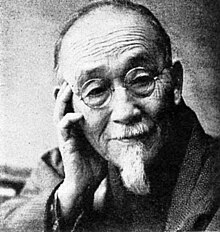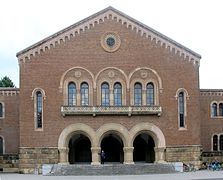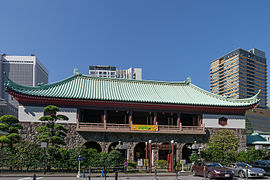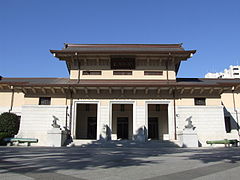Itō Chūta
Itō Chūta ( Japanese 伊 東 忠 太 ; born January 18, 1867 in Yonezawa ; † October 24, 1954 ) was a modern Japanese architect of the second generation. He strove to combine modern with traditional Japanese architecture.
Live and act
Itō graduated from Tokyo University in 1892 and continued his post-graduate studies, studying the history of Japanese architecture . He pointed out the beauty of traditional architecture and the need to preserve it. In 1895 he was instrumental in the designs for the Heian Shrine in Kyoto.
In 1897 Ito became a professor at the University of Tokyo and became the first modern architect to take part in projects for Shinto architecture , for example the restoration of the Ise Shrine .
Itō dealt with the history of Far Eastern architecture, made a. a. the Yungang Grottoes are known to a wider public. His works show a wide range of styles, ranging from traditional Japanese temple architecture to Indian to western-looking works. They are well documented in the six volumes Itō Chūta kenchiku bunken .
In 1943 Itō was awarded the Japanese Order of Culture .
Works (selection)
- 1927 Lecture hall of the Tokyo Commercial High School ( 東京 商科 大学 , Tōkyō Shōka Daigaku ), now Kanematsu lecture hall ( 兼 松 講堂 , Kanematsu kōdō ) of Hitotsubashi University
- 1927 Ōkura Shūkokan ( 大 倉 集 古 館 ), art collection of the entrepreneur Ōkura Kihachirō (1837–1928)
- 1931 Tōkyōto fukkō kinenkan ( 東京 都 復興 記念 館 ), museum commemorating the Kantō earthquake in Tokyo in 1923
- 1932 Yūshū-kan ( 遊 就 館 ), reconstruction of the museum building inside the Yasukuni shrine that was destroyed by the Kantō earthquake
- 1934 Tsukiji Hongan-ji ( 築 地 本 願 寺 ), Buddhist temple in Tokyo
gallery
literature
- Tazawa Yutaka: Itō Chūta in: Biographical Dictionary of Japanese Art . Kodansha International, 1981. ISBN 0-87011-488-3 .
Web links
| personal data | |
|---|---|
| SURNAME | Itō, Chūta |
| ALTERNATIVE NAMES | 伊 東 忠 太 (Japanese) |
| BRIEF DESCRIPTION | Japanese architect |
| DATE OF BIRTH | January 18, 1867 |
| PLACE OF BIRTH | Yonezawa |
| DATE OF DEATH | October 24, 1954 |






